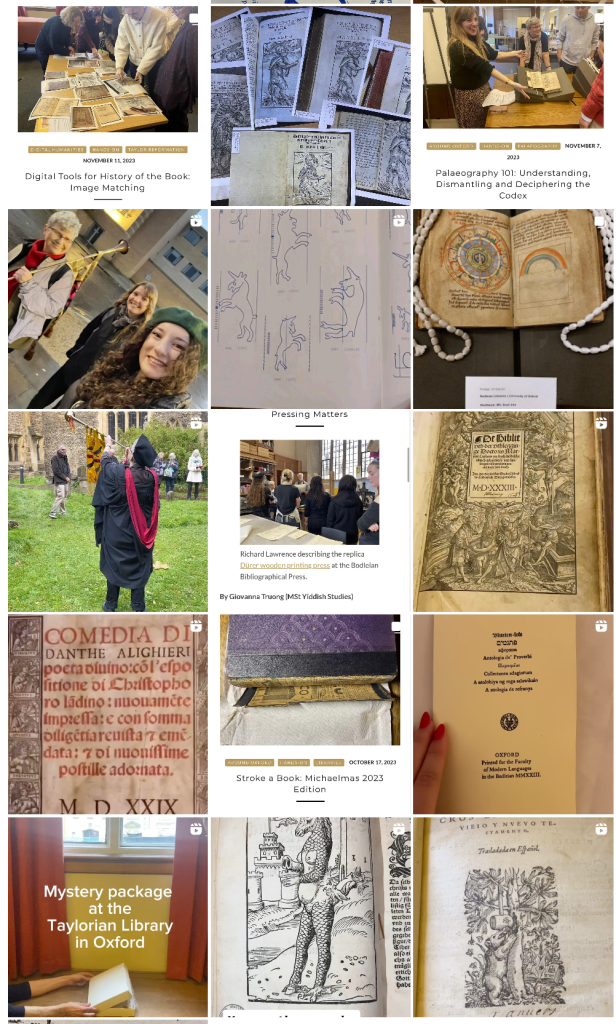During Michaelmas Term 2023, Kira Kohlgrüber (Frankfurt) and Karen Wenzel (Augsburg) worked as research interns with Henrike Lähnemann. Here Kira reports on behalf of both of them on highlights of their time in the city, on working with manuscripts, Reformation pamphlets, and xml, and being part of the History of the Book group at the Faculty of Medieval and Modern Languages.
When I flew to Oxford in September, it was a very exciting experience. Initially, I gained a considerable amount of technical knowledge related to working with digital editions through the XML Summer School. In the beginning, I was somewhat on my own, but I had the opportunity to explore Oxford, its beautiful architecture, and meet its very friendly people. Early on, I participated in the two-day workshop titled Itinaries of the Grotesque by Raphaële Garrod and Raymond Carlson. The workshop explored the various natures of grotesque representations in art and literature from different European and transatlantic origins. It took place at the beautiful Magdalen College in Oxford, providing a fascinating insight into interdisciplinary work across various disciplines.
After a few weeks, Karen joined, and it was delightful to share the experience of an internship at such a prestigious university as Oxford with another person. At the start of the actual internship, it wasn’t entirely clear how our time in Oxford would unfold. Henrike Lähnemann had mentioned some topics that might come up during the Michaelmas Term, but the specifics of what we, as interns, would be doing were clarified only shortly before. The initial days in England were relatively relaxed, with organizational events, introductions to buildings, and the internship, leaving enough time to explore the city in the afternoons.
Soon, it became apparent that our main task would be contributing to the edition of the Lutheran pamphlet called the “Mönchkalb.” Since there was still much work to be done on this edition, it occupied almost the entire term. We were able to support and directly engage in the editing work. Previously, we hadn’t dealt much with Luther’s pamphlets and had primarily worked with manuscripts rather than prints, especially not with editions in four different languages. However, this work in a related but new field added to the allure. I worked on completing the French version and Karen on the Latin Interpretatio Monachouituli Monstri Fribergae .

Amidst this work, there was still time for other activities. Henrike Lähnemann frequently encouraged us to attend various events and visit different places. For instance, in early November, we had the opportunity to attend the one-day workshop Germanic Collections in Britain at UCL in London.
Additionally, we had the chance to try our hand at early modern printing presses. The Bodleian Libraries’ print workshop had several printing presses, with a special highlight being a replica of the Dürer press made of wood, operated with considerable physical effort. We were able to print the fascinating and handmade Dürer alphabet. Being in a real printing press, manually bringing our texts to paper with lead letters and ink, felt like a leap back into the early modern period. This experience helped us better understand the typographical errors in Luther’s texts, as it’s remarkably easy to grab the wrong letter in the heat of the moment.

Participating in seminars was another aspect of the internship. In the “History of the Book” seminar led by Henrike Lähnemann, we explored various interesting topics related to books throughout different centuries. Simultaneously, we regularly exchanged ideas with students from various language areas. The second weekly course focused on the Graduate Medieval Seminar, which, during the Michaelmas Term, delved into Konrad Fleck’s text “Flore und Blanscheflur.” We had heard of the work before but had not really engaged with the text ourselves. The weekly changing topics allowed for diverse and interesting approaches to the medieval work, and we learned a lot.
The combination of scholarly work, interaction with students and scholars, made for a compelling and unique experience. The activities related to the edition of the “Mönchkalb” were extremely diverse and challenging. Our tasks included simple proofreading, encoding texts using XML, and going on a wild college tour to inspect all copies of the Latin edition of Luther’s works in the college libraries, measuring and comparing the original woodcuts. These varied tasks not only deepened our knowledge in the field of text editing but also expanded our skills in handling historical prints and digital encoding processes. One unexpected aspect was the training of social media skills. We took photos or recorded videos at various events organized by Henrike Lähnemann or the “History of the Book” seminar and used them to set up an Instagram account.

Both the internship and the work on the edition culminated in the launch event on 1 December 2023. Alongside many other participants, we publicly read a portion of the German edition text and celebrated the completion of the work with printed edition copies in hand. However, the work wasn’t entirely finished, as there were still some tasks for the digital representation of the edition on the website.
It was wonderful to complete the internship together and mutually support each other. Apart from the office, we also met many interesting and incredibly nice people in Oxford. Both socially and professionally, the internship was a significant enrichment, and it’s a bit sad to leave the city and the people after the term ends.
Oxford has certainly not seen the last of us.

